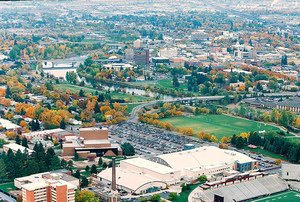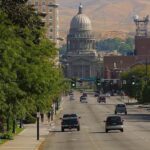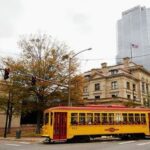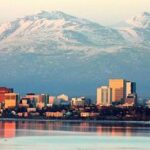This article, the twenty-sixth in a 50-state series, lists the twenty largest cities in Montana by population size and provides demographic details for each city: total population, population by age group, racial composition of the population, land area, and population density. For purposes of this article, cities are incorporated municipalities and census-designated places (CDPs).
After reading “Largest Cities in Montana (2011),” return to this link to read “Best Places to Live in Montana (2011) .”
Similar articles for the remaining 49 states can be found at these links: Alabama, Alaska, Arizona, Arkansas, California, Colorado, Connecticut, Delaware, Florida, Georgia, Hawaii, Idaho, Illinois, Indiana, Iowa, Kansas, Kentucky, Louisiana, Maine, Maryland, Massachusetts, Michigan, Minnesota, Missouri, Mississippi, Nebraska, Nevada, New Hampshire, New Jersey, New Mexico, New York, North Carolina, North Dakota, Ohio, Oklahoma, Oregon, Pennsylvania, Rhode Island, South Carolina, South Dakota, Tennessee, Texas, Utah, Vermont, Virginia, Washington, West Virginia, Wisconsin, and Wyoming .
1. Largest Cities in Montana (2011): Billings, MT
Located in the central part of southern Montana, Billings is the largest city in the state with an estimated population of 104,170.
Grouped by age, 22.6% of the population is under 18, 9.9% is 18 to 24, 26.3% is 25 to 44, 26.3% is 45 to 64, and 14.9% is 65 or older. The median age of the population is 37.5.
The racial composition of the city is 89.6% White, 0.8% Black or African American, 4.4% Native American, 0.7% Asian, 0.1% Pacific Islander, 1.4% from other races, and 2.9% from two or more races. The population is 5.2% Hispanic or Latino of any race.
The land area of the city is 33.7 square miles. The city’s population density is 3,091 people per square mile.
2. Largest Cities in Montana (2011): Missoula, MT
Situated in the central part of western Montana, Missoula is the second largest city in the state with an estimated population of 66,788.
A comparatively large part of the population is college-aged: the city is home to the University of Montana. Classified by age, 17.9% of the population is under 18, 19.7% is 18 to 24, 29.6% is 25 to 44, 22.1% is 45 to 64, and 10.7% is 65 or older. The median age of the population is 30.9.
The racial complexion of the city is 92.1% White, 0.5% Black or African American, 2.8% Native American, 1.2% Asian, 0.1% Pacific Islander, 0.5% from other races, and 2.8% from two or more races. The population is 2.9% Hispanic or Latino of any race.
The land area of the city is 23.8 square miles. The city’s population density is 2,806 people per square mile.
3. Largest Cities in Montana (2011): Great Falls, MT
Located in the northwestern part of central Montana, Great Falls is the third largest city in the state with an estimated population of 58,505.
Categorized by age, 22.5% of the population is under 18, 9.8% is 18 to 24, 24.5% is 25 to 44, 26.5% is 45 to 64, and 16.7% is 65 or older. The median age of the population is 39.0.
The racial profile of the city is 88.5% White, 1.1% Black or African American, 5.0% Native American, 0.9% Asian, 0.1% Pacific Islander, 0.6% from other races, and 3.8% from two or more races. The population is 3.4% Hispanic or Latino of any race.
The land area of the city is 19.5 square miles. The city’s population density is 3,000 people per square mile.
4. Largest Cities in Montana (2011): Bozeman, MT
Located in southwestern Montana, Bozeman is the fourth largest city in the state with an estimated population of 37,280.
A large part of the population is college-aged: the city is home to Montana State University. Arranged by age, 15.7% of the population is under 18, 28.1% is 18 to 24, 31.4% is 25 to 44, 16.7% is 45 to 64, and 8.1% is 65 or older. The median age of the population is 27.2.
The racial mix of the city is 93.6% White, 0.5% Black or African American, 1.1% Native American, 1.9% Asian, 0.1% Pacific Islander, 0.7% from other races, and 2.1% from two or more races. The population is 2.9% Hispanic or Latino of any race.
The land area of the city is 20.3 square miles. The city’s population density is 1,836 people per square mile.
5. Largest Cities in Montana (2011): Butte-Silver Bow, MT
Situated in southwestern Montana, Butte-Silver Bow is the fifth largest city in the state with an estimated population of 33,525.
Sorted by age, 21.0% of the population is under 18, 10.9% is 18 to 24, 22.6% is 25 to 44, 29.1% is 45 to 64, and 16.4% is 65 or older. The median age of the population is 41.3.
The racial makeup of the city is 94.4% White, 0.3% Black or African American, 1.9% Native American, 0.5% Asian, 0.1% Pacific Islander, 0.7% from other races, and 2.1% from two or more races. The population is 3.7% Hispanic or Latino of any race.
The land area of the city is 716.1 square miles. The city’s population density is 47 people per square mile.
6. Largest Cities in Montana (2011): Helena, MT
Located in western Montana, Helena is the state’s capital and sixth largest city with an estimated population of 28,190.
Arranged by age, 21.1% of the population is under 18, 10.5% is 18 to 24, 23.3% is 25 to 44, 29.5% is 45 to 64, and 15.6% is 65 or older. The median age of the population is 40.3.
The racial mix of the city is 93.3% White, 0.4% Black or African American, 2.3% Native American, 0.7% Asian, 0.1% Pacific Islander, 0.6% from other races, and 2.6% from two or more races. The population is 2.8% Hispanic or Latino of any race.
The land area of the city is 14.0 square miles. The city’s population density is 2,014 people per square mile.
7. Largest Cities in Montana (2011): Kalispell, MT
Situated in northwestern Montana, Kalispell is the seventh largest city in the state with an estimated population of 19,927.
Sorted by age, 25.1% of the population is under 18, 9.6% is 18 to 24, 27.2% is 25 to 44, 22.7% is 45 to 64, and 15.4% is 65 or older. The median age of the population is 34.5.
The racial makeup of the city is 94.2% White, 0.2% Black or African American, 1.3% Native American, 1.0% Asian, and 0.1% Pacific Islander, 0.6% from other races, and 2.6% from two or more races. The population is 2.9% Hispanic or Latino of any race.
The land area of the city is 5.5 square miles. The city’s population density is 3,623 people per square mile.
8. Largest Cities in Montana (2011): Havre, MT
Located in the central part of northern Montana, Havre is the eighth largest city in the state with an estimated population of 9,310.
Categorized by age, 25.1% of the population is under 18, 12.9% is 18 to 24, 23.5% is 25 to 44, 25.2% is 45 to 64, and 13.3% is 65 or older. The median age of the population is 33.9.
The racial profile of the city is 81.6% White, 0.4% Black or African American, 13.0% Native American, 0.6% Asian, 0.1% Pacific Islander, 0.3% from other races, and 4.0% from two or more races. The population is 2.5% Hispanic or Latino of any race.
The land area of the city is 3.5 square miles. The city’s population density is 2,660 people per square mile.
9. Largest Cities in Montana (2011): Anaconda-Deep Lodge County, MT
Located in southwestern Montana, Anaconda-Deep Lodge County, a consolidated city-county, is the ninth largest city in the state with an estimated population of 9,298.
Arranged by age, 18.9% of the population is under 18, 8.5% is 18 to 24, 21.6% is 25 to 44, 31.8% is 45 to 64, and 19.2% is 65 or older. The median age of the population is 46.0.
The racial mix of the city is 93.1% White, 0.4% Black or African American, 3.1% Native American, 0.3% Asian, 0.5% from other races, and 2.5% from two or more races. The population is 2.9% Hispanic or Latino of any race.
The land area of the city is 737 square miles. The city’s population density is 13 people per square mile.
10. Largest Cities in Montana (2011): Miles City, MT
Situated in southeastern Montana, Miles City is the tenth largest city in the state with an estimated population of 8,410.
Sorted by age, 23.4% of the population is under 18, 8.5% is 18 to 24, 22.7% is 25 to 44, 27.6% is 45 to 64, and 17.8% is 65 or older. The median age of the population is 40.6.
The racial makeup of the city is 95.3% White, 0.3% Black or African American, 1.7% Native American, 0.4% Asian, 0.1% Pacific Islander, 0.6% from other races, and 1.6% from two or more races. The population is 2.4% Hispanic or Latino of any race.
The land area of the city is 33.0 square miles. The city’s population density is 2,549 people per square mile.
11. Largest Cities in Montana (2011): Helena Valley Southeast, MT
Located in western Montana, Helena Valley Southeast is the eleventh largest city in the state with an estimated population of 8,227.
Grouped by age, 28.9% of the population is under 18, 7.9% is 18 to 24, 27.1% is 25 to 44, 27.9% is 45 to 64, and 8.2% is 65 or older. The median age of the population is 34.6.
The racial composition of the city is 92.6% White, 0.3% Black or African American, 2.8% Native American, 0.4% Asian, 0.1% Pacific Islander, 0.5% from other races, and 3.3% from two or more races. The population is 2.5% Hispanic or Latino of any race.
The land area of the city is 16.2 square miles. The city’s population density is 508 people per square mile.
12. Largest Cities in Montana (2011): Helena Valley West Central, MT
Situated in western Montana, Helena Valley West Central is the twelfth largest city in the state with an estimated population of 7,883.
Classified by age, 25.8% of the population is under 18, 6.9% is 18 to 24, 23.0% is 25 to 44, 32.2% is 45 to 64, and 12.1% is 65 or older. The median age of the population is 40.8.
The racial complexion of the city is 95.4% White, 0.3% Black or African American, 1.2% Native American, 0.5% Asian, 0.1% Pacific Islander, 0.4% from other races, and 2.0% from two or more races. The population is 2.0% Hispanic or Latino of any race.
The land area of the city is 26.6 square miles. The city’s population density is 296 people per square mile.
13. Largest Cities in Montana (2011): Evergreen, MT
Located in northwestern Montana, Evergreen is the thirteenth largest city in the state with an estimated population of 7,616.
Categorized by age, 24.3% of the population is under 18, 10.2% is 18 to 24, 24.4% is 25 to 44, 29.0% is 45 to 64, and 12.1% is 65 or older. The median age of the population is 37.8.
The racial profile of the city is 94.5% White, 0.2% Black or African American, 1.5% Native American, 0.4% Asian, 0.1% Pacific Islander, 0.6% from other races, and 2.7% from two or more races. The population is 2.8% Hispanic or Latino of any race.
The land area of the city is 8.0 square miles. The city’s population density is 952 people per square mile.
14. Largest Cities in Montana (2011): Belgrade, MT
Located in southwestern Montana, Belgrade is fourteenth largest city in the state with an estimated population of 7,389.
Arranged by age, 15.7% of the population is under 18, 28.1% is 18 to 24, 31.4% is 25 to 44, 16.7% is 45 to 64, and 8.1% is 65 or older. The median age of the population is 27.2.
The racial mix of the city is 93.6% White, 0.5% Black or African American, 1.1% Native American, 1.9% Asian, 0.1% Pacific Islander, 0.7% from other races, and 2.1% from two or more races. The population is 2.9% Hispanic or Latino of any race.
The land area of the city is 1.7 square miles. The city’s population density is 4,347 people per square mile.
15. Largest Cities in Montana (2011): Livingston, MT
Situated in southwestern Montana, Livingston is the fifteenth largest city in the state with an estimated population of 7,044.
Sorted by age, 21.0% of the population is under 18, 5.6% is 18 to 24, 28.3% is 25 to 44, 28.9% is 45 to 64, and 16.2% is 65 or older. The median age of the population is 41.1.
The racial makeup of the city is 96.2% White, 0.1% Black or African American, 0.8% Native American, 0.3% Asian, 0.6% from other races, and 2.0% from two or more races. The population is 2.5% Hispanic or Latino of any race.
The land area of the city is 2.6 square miles. The city’s population density is 2,709 people per square mile.
16. Largest Cities in Montana (2011): Lockwood, MT
Situated in the central part of southern Montana, Lockwood is the sixteenth largest city in the state with an estimated population of 6,797.
Sorted by age, 28.5% of the population is under 18, 7.9% is 18 to 24, 26.8% is 25 to 44, 27.7% is 45 to 64, and 9.1% is 65 or older. The median age of the population is 35.8.
The racial makeup of the city is 89.5% White, 0.4% Black or African American, 4.9% Native American, 0.1% Asian, 1.4% from other races, and 3.7% from two or more races. The population is 6.0% Hispanic or Latino of any race.
The land area of the city is 7.5 square miles. The city’s population density is 906 people per square mile.
17. Largest Cities in Montana (2011): Laurel, MT
Located in the central part of southern Montana, Laurel is the seventeeth largest city in the state with an estimated population of 6,718.
Grouped by age, 25.3% of the population is under 18, 7.9% is 18 to 24, 26.1% is 25 to 44, 24.8% is 45 to 64, and 15.9% is 65 or older. The median age of the population is 37.0.
The racial composition of the city is 95.3% White, 0.4% Black or African American, 1.5% Native American, 0.4% Asian, 0.4% from other races, and 2.1% from two or more races. The population is 3.0% Hispanic or Latino of any race.
The land area of the city is 1.9 square miles. The city’s population density is 3,535 people per square mile.
18. Largest Cities in Montana (2011): Whitefish, MT
Situated in northwestern Montana, Whitefish is the eighteenth largest city in the state with an estimated population of 6,357.
Classified by age, 19.6% of the population is under 18, 7.0% is 18 to 24, 30.2% is 25 to 44, 28.9% is 45 to 64, and 14.3% is 65 or older. The median age of the population is 40.1.
The racial complexion of the city is 95.8% White, 0.5% Black or African American, 0.8% Native American, 0.8% Asian, 0.1% Pacific Islander, 0.3% from other races, and 1.7% from two or more races. The population is 2.8% Hispanic or Latino of any race.
The land area of the city is 4.4 square miles. The city’s population density is 1,445 people per square mile.
19. Largest Cities in Montana (2011): Lewistown, MT
Located in central Montana, Lewistown is the nineteenth largest city in the state with an estimated population of 5,901.
Categorized by age, 20.4% of the population is under 18, 6.4% is 18 to 24, 22.6% is 25 to 44, 28.9% is 45 to 64, and 21.7% is 65 or older. The median age of the population is 45.4.
The racial profile of the city is 95.4% White, 0.3% Black or African American, 1.7% Native American, 0.4% Asian, 0.3% from other races, and 2.0% from two or more races. The population is 2.1% Hispanic or Latino of any race.
The land area of the city is 1.9 square miles. The city’s population density is 3,106 people per square mile.
20. Largest Cities in Montana (2011): Orchard Homes, MT
Located in the central part of western Montana, Orchard Homes is the twentieth largest city in the state with an estimated population of 5,197.
Arranged by age, 20.9% of the population is under 18, 8.1% is 18 to 24, 22.7% is 25 to 44, 33.4% is 45 to 64, and 14.9% is 65 or older. The median age of the population is 43.4.
The racial mix of the city is 93.1% White, 0.2% Black or African American, 2.0% Native American, 1.8% Asian, 0.1% Pacific Islander, 0.4% from other races, and 2.4% from two or more races. The population is 2.2% Hispanic or Latino of any race.
The land area of the city is 6.4 square miles. The city’s population density is 812 people per square mile.
Source(s):
“American Fact Finder,” U.S. Census Bureau
“Population, Housing Units, Area, and Density: 2000,” U.S. Census Bureau








